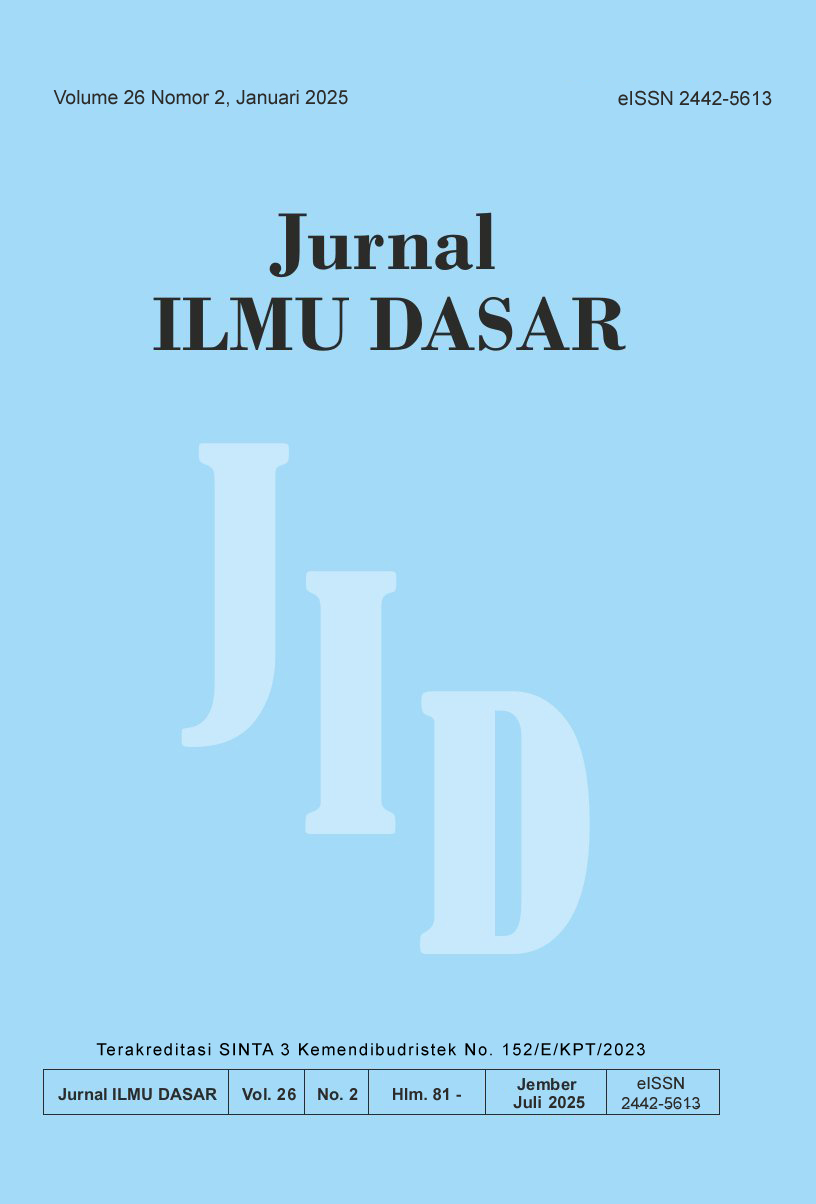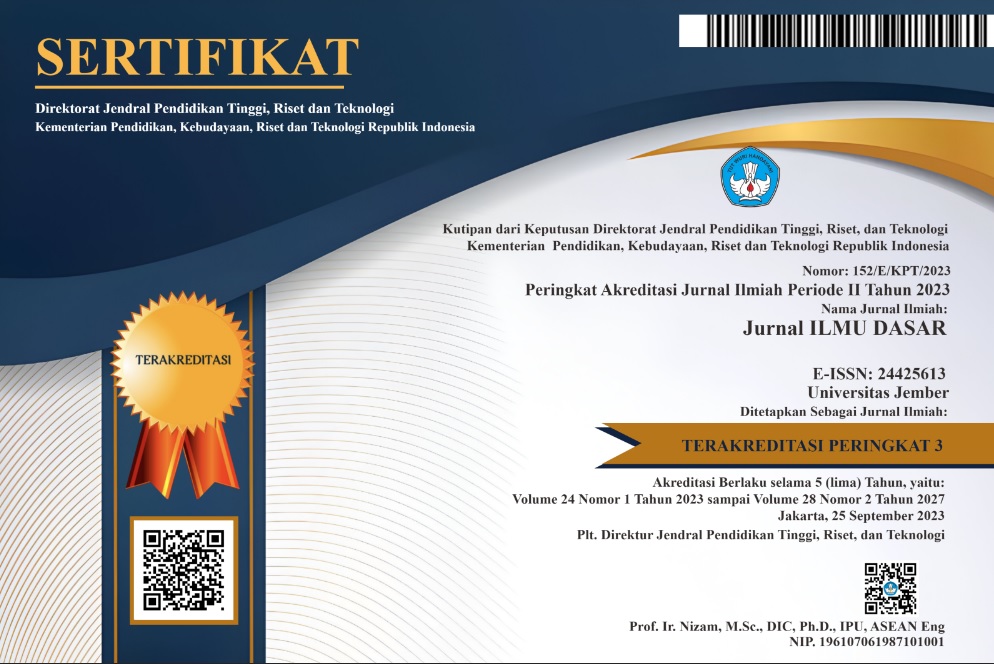Evaluation of Biofertilizer on Growth and Productivity of Solanum lycopersicum L.
DOI:
https://doi.org/10.19184/jid.v26i2.53696Keywords:
Biofertilizer, Plant Growth, Productivity, Solanum lycopersicum LAbstract
The increasing demand for tomatoes has prompted farmers to use chemical fertilizers, which can lead to soil degradation and reduced fertility. This study aims to determine the appropriate dose and frequency of biofertilizer application to enhance the growth and productivity of tomato plants (Solanum lycopersicum L.). The experiment was designed using a Completely Randomized Design (CRD) with 11 treatments, including both negative and positive controls. Three variations in biofertilizer doses were tested (5, 10, and 15 ml/plant), along with three different frequencies of application: once at one week after planting (1 WAP), twice (at 1 and 4 WAP), and three times (at 1, 4, and 8 WAP). Measured parameters included soil fertility (microbial population and functional microbial quality), plant growth (plant height, leaf count, stem diameter), and plant productivity (flower count). Quality of functional microbes were analyzed descriptively. Data of microbial population, plant growth and productivity were analyzed using Kruskal-Wallis and Mann-Whitney tests with a 5% significance level. The results showed significant differences in soil microbial populations and plant height between treatments, although no significant differences were observed in stem diameter, leaf number, or flower number. The treatment with 15 ml/plant applied three times (B15F3) exhibited the highest Relative Agronomic Efficiency (RAE) compared to other biofertilizer treatments (74.63%), but it was still lower than the control (chemical fertilizer). Therefore, higher doses and/or frequencies may be needed to further evaluate the effectiveness of the biofertilizer under test.
Downloads
References
Alamsyah, A. R. F., & Fitriyah, N. (2018). Pengaruh mikoriza dan em4 terhadap pertumbuhan dan produktivitas tanaman tomat (Solanum lycopersicum L.). Jurnal Ilmiah Hijau Cendekia, 3(1), 14–19.
Astari, W., Purwani, K. I., & Anugerahani, W. (2014). Pengaruh aplikasi pupuk hayati terhadap pertumbuhan dan produktivitas tanaman tomat (Solanum lycopersicum L.) Var. Tombatu di PT Petrokimia Gresik. Jurnal Sains Dan Seni Pomits, 2(1), 1–4.
Chaparro, J. M., Badri, D. V, & Vivanco, J. M. (2014). Rhizosphere microbiome assemblage is affected by plant development. The ISME Journal, 8(4), 790–803.
Chaudhary, P., Agri, U., Chaudhary, A., Kumar, A., & Kumar, G. (2022). Endophytes and Their Potential in Biotic Stress Management and Crop Production, Frontiers in microbiology, 13, 933017.
Dwi Retnowati, I. (2017). Respon hasil tiga varietas tomat (Lycopersicum esculentum M.) dengan aplikasi ba (benziladen).
Fathi, A. (2022). Role of nitrogen (N) in plant growth, photosynthesis pigments, and N use efficiency: A review. Agrisost, 28, 1–8. https://doi.org/10.5281/zenodo.7143588
Fatimah, Annizah, I. N., Alawiyah, D. D., Susetyo, R. D., Surtiningsih, T., & Nurhariyati, T. (2021). Phosphate solubilizing bacteria isolated from Tuban mangrove soil, Indonesia. IOP Conference Series: Earth and Environmental Science, 762(1), 012007.
Fatimah, F., Fadilah, R. L. A., Millah, A. I., Nurhariyati, T., Irawan, B., Affandi, M., Zuhri, A. R. N. I., Widhiya, E. W., Salsabila, S., & Ramly, Z. A. (2022). Ability test of IAA (Indole-3-Acetic Acid) hormone-producing endophytic bacteria from Lamongan Mangrove. Jurnal Riset Biologi Dan Aplikasinya, 4(1), 42–50.
Fatimah, Jannah, Z., Suroiyah, F., Azzah, Salamun, Nurhariyati, T., & Surtiningsih, T. (2020). Exploration of proteolytic bacteria from Mangrove Center Tuban soil. Annalsofbiology, 36(2), 267–271.
Ferrando, L., & Fernández Scavino, A. (2015). Strong shift in the diazotrophic endophytic bacterial community inhabiting rice (Oryza sativa) plants after flooding. FEMS Microbiology Ecology, 91(9), fiv104.
Jenderal -Kementerian Pertanian, S. (2023). Statistics of food consumption 2023. pusat data dan sistem informasi pertanian center for agricultural data and information system.
Khan, B. M. M., Arifin, Z. A., & Zulfarosda, R. (2021). Pengaruh Pemberian Pupuk Kandang Sapi Terhadap Pertumbuhan Dan Hasil Tanaman Jagung Manis (Zea Mays L. Saccharata Sturt.). Journal of Applied Agricultural Sciences, 3(2), 113-120.
Li, A., Shi, Z., Yin, Y., Fan, Y., Zhang, Z., Tian, X., Yang, Y., & Pan, L. (2023). Excessive use of chemical fertilizers in catchment areas raises the seasonal pH in natural freshwater lakes of the subtropical monsoon climate region. Ecological Indicators, 154, 110477. https://doi.org/https://doi.org/10.1016/j.ecolind.2023.110477
Li, J., Deng, G., Liu, H., Wang, X., Zaman, Q., Sultan, K., Saud, S., El-Kahtany, K., Fahad, S., Qian, F., & Chen, S. (2023). Plant-Growth-Promoting Bioagents: A Sustainable Tool for Improving the Soil Health, Enhancing the Growth and Antioxidative Defense System of Tobacco. Plant Stress, 10, 100238.
Nazimah, N., Nilahayati, N., & Jeffri, A. (2020). Respon Pemberian Pupuk Hayati Terhadap Pertumbuhan Dan Produksi Dua Varietas Tanaman Tomat (Lycopersicum esculentum Mill.). Jurnal Agrium, 17. https://doi.org/10.29103/agrium.v17i1.2357
Okur, N. (2018). A review-bio-fertilizers-power of beneficial microorganisms in soils. Biomed. J. Sci. Tech. Res, 4(4), 4028–4029.
Paes da Costa D., das Gracas Espindola da Silva T., Sergio Ferreira Araujo A., Prudencio de Araujo Pereira A., William Mendes L., dos Santos Borges W., et al. (2024). Soil Fertility Impct on Recruitment and Diversity of The Soil Microbiome in Sub-humis Tropical Pastures in Northeastern Brazil. Scientific Reports, 14, 3919-3915.
Pujiastuti, A., & Kristiani, M. (2019). Formulasi dan Uji Stabilitas Mekanik Hand and Body Lotion Sari Buah Tomat (Licopersicon esculentum Mill.) sebagai Antioksidan Formulation and Mechanical Stability Test for Hand and Body Lotionfrom Tomato Juice (Licopersiconesculentum Mill.) as Antioxidants. Jurna lfarmasi indonesia, 16(1), 42–55. http://ejurnal.setiabudi.ac.id/ojs/index.php/farmasi-indonesia
Rana, A., Setiawati, M. R., & Suriadikusumah, A. (2018). Pengaruh Pupuk Hayati dan Anorganik terhadap Populasi Bakteri Pelarut Fosat, Kandungan Fosfat (P), dan Hasil Tomat Hidroponik. Jurnal Biodjati, 3(1), 15-22.
Sinha, R. K., Valani, D., Chauhan, K., & Agarwal, S. (2010). Embarking on a second green revolution for sustainable agriculture by vermiculture biotechnology using earthworms: reviving the dreams of Sir Charles Darwin. Journal of Agricultural Biotechnology and Sustainable Development, 2(7), 113.
Sriwahyuni, P., & Parmila, P. (2019). Peran bioteknologi dalam pembuatan pupuk hayati. Agricultural Journal, 2(1).
Van Maarschalkerweerd, M., & Husted, S. (2015). Recent developments in fast spectroscopy for plant mineral analysis. Frontiers in Plant Science, 6, 169.
Wulandari, S. (2021). Pengaruh konsentrasi pgpr (plant growth promoting rhizobacteria) dan pupuk kcl terhadap pertumbuhan dan produksi pada tanaman tomat in Solanum lycopersicum L.). Jurnal AGrotekMAS, 2(3). https://jurnal.fp.umi.ac.id/index.php/agrotekmas76.
Downloads
Published
Issue
Section
License
Copyright (c) 2025 Princessa Nandita Febrionny, Annisa Azzahra, Syarifah Salsabila, Niken Agustin, Aqilla Kalyca Tamalia, Ajeng Distya Anjani, Junairiah, Fatimah

This work is licensed under a Creative Commons Attribution-ShareAlike 4.0 International License.








